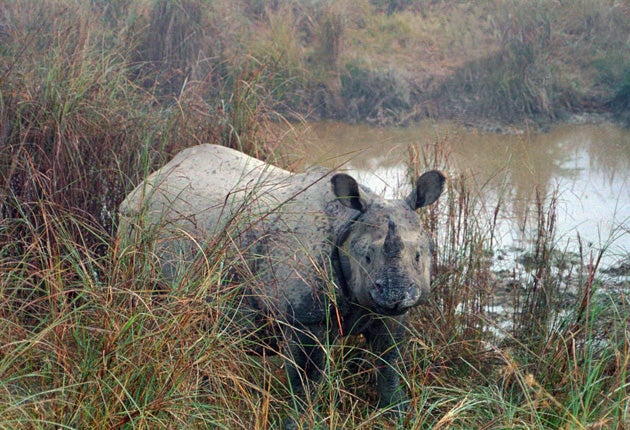While politicians' backs are turned, poachers target Nepal's rhinos

Your support helps us to tell the story
From reproductive rights to climate change to Big Tech, The Independent is on the ground when the story is developing. Whether it's investigating the financials of Elon Musk's pro-Trump PAC or producing our latest documentary, 'The A Word', which shines a light on the American women fighting for reproductive rights, we know how important it is to parse out the facts from the messaging.
At such a critical moment in US history, we need reporters on the ground. Your donation allows us to keep sending journalists to speak to both sides of the story.
The Independent is trusted by Americans across the entire political spectrum. And unlike many other quality news outlets, we choose not to lock Americans out of our reporting and analysis with paywalls. We believe quality journalism should be available to everyone, paid for by those who can afford it.
Your support makes all the difference.Amid constitutional chaos and political uncertainty, officials in Nepal have been forced to turn their attention to the country's threatened wildlife, revealing that at least 28 rhinos have died in the last year. More than half of the endangered animals were killed by poachers, in a national park supposedly guarded by troops.
Prime Minister Madhav Kumar Nepal, confronting intense pressure from Maoist political opponents, was forced to call an emergency meeting with wildlife officials and promise to launch an immediate inquiry into the deaths of the rhinos.
Indian rhinos – one of five species – are native to northern India and southern Nepal. Before stringent preservation laws were introduced in the middle of the 20th century, there were fewer than 200 still alive. Now there are an estimated 2,500 in the wild, many of them in India's Kaziranga National Park.
In the 1950s, Nepal claimed it had an estimated population of 800 rhinos, but that number has steadily fallen. With a decade-long civil war that ended in 2006 and persistent political uncertainty since then, experts say politicians have been distracted from areas such as wildlife preservation. The latest census of the animals was in 2008 when they were said to total 435.
Officials said the rhino deaths occurred in Chitwan National Park, in the Terai district of southern Nepal. The park is guarded by soldiers, who sometimes go on patrol on the backs of elephants, but some have reportedly been redeployed in recent weeks amid ongoing protests in many of Nepal's cities. Some reports said that a number of the rhinos had been killed close to army posts in the park.
Department of Forest and Wildlife Conservation official Megh Bahadur Pandey said: "Stopping the poaching is a major challenge for us. There is always an increase in poaching of wildlife in the conservation area when there are political problems."
Experts say that many efforts have been made to protect the rhinos, whose horn is highly valued as a sexual stimulant in traditional medicine in East Asia. Local communities have been included in protecting the animals and helping warn about incursions by poachers. However, sometimes things go wrong; three Dalit women were recently shot by soldiers who suspected them of being poachers, triggering a massive outcry.
"The trouble is that there are insufficient resources for the park," said Diwakar Chapagain, a wildlife protection officer with the World Wide Fund for Nature (WWF) in Nepal who took part in Sunday's emergency meeting that was attended by police and army commanders. "It is a big area and there are not enough security personnel to cover it all. It is also very hard during the monsoon season – there is a lot of mud."
Mr Chapagain said it was unclear precisely where the demand for the rhino products was coming from. "When we catch poachers they don't know anything," he said. "We only ever get the middle man – no one knows who the top man is."
The challenge of dealing with the threat to the rhino comes as Nepal struggles with intense political uncertainty. A special assembly elected to draw up a new constitution has failed to produce one within the deadline and there is pressure from all sides on Mr Nepal to resign. He has said he will stand down, but only once there is an agreement about the formation of a national coalition government.
Join our commenting forum
Join thought-provoking conversations, follow other Independent readers and see their replies
Comments